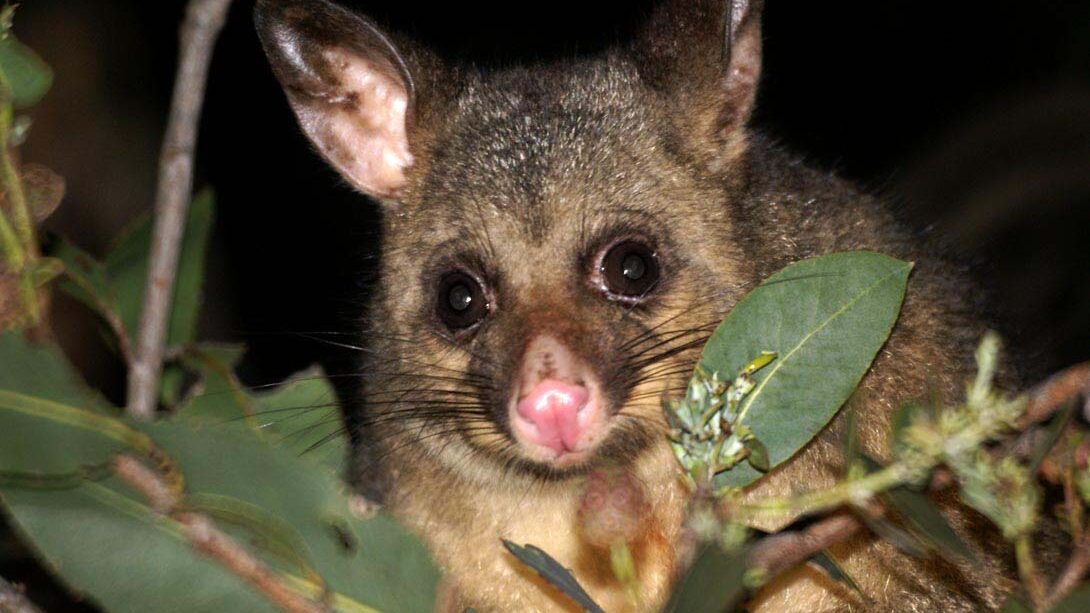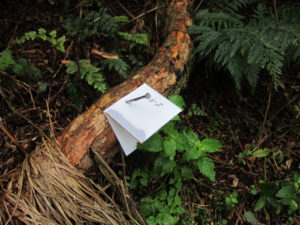When researchers tested a dual baiting regime on ship rats back in 2016-2017, they also made some interesting observations about possum behaviour in their study area. Could dual baiting be adapted to overcome the bait-shy behaviour of possum survivors too?

Department of Conservation and Landcare Research scientists, Graham Nugent, Richard Clayton, Bruce Warburton and Tim Day came up with a possum 1080 bait-switching regime for possums and put it to the test in a pine plantation near Rotorua.
“In a 2016–2017 trial using Orillion RS5 cereal bait, we showed that bait-averse ship rats (Rattus rattus) could be killed by changing the RS5 bait type slightly for the second 1080 baiting (by surface-coating it with a proprietary deer repellent that changed the appearance and smell of the bait), and by pre-feeding survivors twice before conducting a second 1080 baiting five months after the first. In contrast, the effectiveness of the second baiting in killing cereal-bait-shy possums was low: indices of possum activity actually increased after the second baiting. However, somewhat serendipitously, bait-shy possums in that study continued to be attracted to and feed on a peanut butter (PB) lure incorporated in chew-card detection devices used to monitor possum and rat abundance before and after the 1080 baitings.”

It seems the possums weren’t as easily fooled as the ship rats, but the attractions of peanut butter might be enough to overcome their caution.
“It was not clear whether acceptance of that lure reflected the marked difference in appearance, smell, taste and texture of the PB paste from the cereal 1080 baits used on the trial, or because possums had been exposed to, and become familiarised with, the PB paste before they were ever exposed to 1080. Here we address that uncertainty in a follow-up trial, and show that by drastically changing the bait type (from cereal pellet to PB paste) and also pre-feeding with the second bait type, either before or after 1080 baiting with the first bait type, the bait aversion problem in surviving possums can be largely overcome or at least circumvented.”
Eliminating possums is a key Predator Free 2050 goal, not only because they prey on eggs and chicks and compete for food with native species, but also because they are the major wildlife host of bovine TB.
“New Zealand’s aspirational goals of being completely free of possums by 2050 and of TB by 2055 are likely to be made much simpler if possums can be eliminated from large forested areas in a single aerial poisoning operation (albeit one possibly involving multiple baitings). Single-operation eradication has already been achieved using an anti-coagulant toxin (brodifacoum), but because of long residue persistence times in non-target species that toxin cannot be used on public conservation land.”
In recent years, aerial 1080 operations have become increasingly effective and precise. But, for various reasons, some possums survive their encounter with poison pellets and become extremely bait averse.

“Aerial 1080 (sodium fluoroacetate) baiting can deliver extremely high kills, with 100% reductions in low-precision indices of possum abundance (i.e. leg-hold traps) recorded as far back as the early 1990s. The use of multiple non-toxic pre-feeds, large uniformly sized baits, high baiting rates, GPS guidance, and broadcast baiting systems appears to ensure every possum encounters 1080 bait, and this approach can achieve very high percentage kill rates (% kill). For example, in 2016 we recorded a 99.6% kill of 243 radio-collared possums in an 80 000 hecgtare area of forest after a mostly twice-pre-fed single sowing of 12 gram 1080 cereal bait. However, there are, as yet, no reports of large-scale local elimination: two years after the operation mentioned above, possums remained detectable at three of four spatially separate intensively monitored areas (each 525 ha).”
“Since 2015 we, and others have investigated whether two sowings of toxic 1080 bait in quick succession, variously termed ‘1080-to-Zero’ or ‘Dual 1080’ might be even more effective. The concept is based on the premise that a few possums will always survive a single 1080 baiting because 1080 is a relatively fast-acting toxin that sometimes acts too quickly for all possums to find and consume a lethal dose. If a possum ingests a substantial, but still sub-lethal dose of 1080 within that short ‘pre-toxicosis’ window, it survives but develops a strong and long-lasting learned aversion to the bait used to poison it.”
The problem isn’t that these possums didn’t encounter the bait – they just didn’t eat enough of it, quickly enough for the dose to be fatal.
“The survival of some possums cannot be attributed to possums simply not encountering bait or refusing to eat the bait type sown, as possums have been successfully eradicated from a 3400 ha predator-proof fenced area by aerial baiting alone using a cereal bait matrix similar to that used in aerial 1080 baiting, but with a different, slower-acting toxin (the anticoagulant brodifacoum). The problem seems to be that a small number of possums survive (and become bait averse), perhaps largely by chance, for a variety of reasons such as lack of appetite through satiation with other foods, or as a result of illness; competitive or other social interactions with other possums; behaviour that reduces the chance of encountering bait (e.g. nesting and foraging predominantly in the canopy), or bait fragmentation during sowing.”
This study was conducted in mid-2018 in a mature Pinus radiata pine plantation 10 km southwest of Rotorua. While possums had previously been trapped for fur in the area, it had not been subject to formal possum control.
“Three study blocks, each 50–80 ha with buffer zones of at least 300 m and usually 500–800 m wide between them, were established, and each was subject to the same dual 1080 baiting treatment, comprising an initial 1080 baiting with the conventional cereal bait used for aerial poisoning, followed by a second 1080 baiting with a PB paste bait currently registered for ground-based poisoning, but with a different nontoxic PB paste pre-feed regime in each block. The PB paste pre-feed was applied only before the cereal baiting in one block, only after it in a second, and both before and after it in a third.”
Possums were fitted with mortality sensing radio collars before the first 1080 baiting, to assess the effectiveness of both 1080 bait applications.
“The purpose of the initial cereal 1080 baiting was, effectively, to deliberately create a population of survivors with a learned aversion to cereal bait, so we did not attempt to familiarise the possums with that bait type ahead of the first toxic baiting (i.e. we did not use cereal pre-feed), and we used the 6 g baits typically employed when both possums and rats are targeted for conservation purposes rather than the 12 g baits typically used in possum control for TB management.”
The non-pre-fed cereal 1080 baiting killed 72.4% of 134 radio-collared possums.
“Subsequent trail camera monitoring of freshly deployed non-toxic cereal baits recorded 31 visits by possibly half of the 19 radio-collared possums that had survived the 1080 cereal baiting but did not record any bait consumption by them, indicating likely bait aversion.”
“Following the second (PB paste) 1080 baiting, 22 (92%) of the remaining 24 possums were killed, all within 72 hours. For the 20 with functioning movement sensors, movement ceased on average 17 hours after sunset on the day bait was laid.”
Two possums survived both the cereal and peanut butter 1080 baitings.
“The two survivors not killed had not been pre-fed before the cereal 1080 baiting. All of the 14 possums in the blocks pre-fed with PB paste either before (nine) or both before and after (five) the first (cereal) 1080 baiting were killed. Although two of 10 possums did survive in the block that was pre-fed only after the first 1080 baiting, the % kill (80%) for the second (PB paste) baiting in that block did not differ significantly from the 100% kill in the other two blocks combined.”
“The overall combined kill for the 129 possums successfully located in the blocks before and after both 1080 baitings was 98.4%. The combined kill was 95% (n = 40) in the post-cereal-1080-pre-fed only block compared to 100% (n = 89) for the other two blocks.”
So switching to a different bait type can work when targeting possums, if the second bait is very different from the first.
“This trial therefore shows that switching to a bait type that differed greatly in smell, taste, texture, and appearance was effective in circumventing learned aversion to the cereal pellet baits now almost universally used in aerial 1080 baiting of possums. It provides field-trial validation of previous findings with captive possums in which 64% of cereal RS5 bait-shy possums were killed with a toxic 1080 gel bait.”
But would scaling up the experiment into a landscape scale operation achieve possum elimination?
“We know from the 99.6% kill of 243 radio-collared possums achieved by a ‘high intensity’ cereal 1080 operation mentioned in the introduction that first applications of 1080 can nowadays achieve high kills. Combining that level of kill with the 92% kill achieved by the second application of 1080 in this study (of 24 presumed mostly cereal-bait-averse possums) suggests that post-cereal-1080 baiting with PB paste is potentially capable of achieving 99.96% kills. Thus, if the pre-poison possum density was one possum per hectare, the resulting residual density could be of the order of one possum per 2500 hectares. Equally simplistically, if the 100% kill of the 14 possums PB-paste-pre-fed before they first encountered 1080 bait can be achieved at operational scales, this would deliver complete elimination.”
Where to from here, then?
“Having demonstrated that a high proportion of survivors of a cereal-bait 1080 operation that are likely to be cereal-bait averse can be killed with a second sowing of 1080 using a markedly different bait, the next questions revolve around how best to operationalise this finding. Pre-feeding the first (cereal) 1080 baiting with non-toxic cereal bait would have improved initial kill, and there are also indications that such pre-feeding reduces the level of bait aversion, possibly also making the second baiting more effective as well.”
“Although not statistically significant, our results hint that the best approach may be to familiarise possums with the bait type that will be used for the second 1080 baiting before they encounter any form of 1080 bait. Whether that might apply in dual 1080 baiting where the two forms of cereal bait already registered for aerial 1080 baiting were used is not known, but it might. If so, that would make adoption of dual 1080 far easier than if use of a very different not-yet-registered bait was necessary.”
Currently, PB paste can’t be delivered aerially and is only registered for ground-based use.
“At present, therefore, a cereal-then-PB-paste dual-1080 regime would be best suited for relatively small-scale use in areas suited to ground-based baiting, with the cereal bait delivered aerially, and hand-laid PB paste then used to ‘mop up’ survivors. For large-scale use, the suggested form of aerial dual-1080 therefore requires development (and registration) of an aerially sowable PB paste (perhaps in biodegradable sachets, as have been used to sow a live TB vaccine for possums in New Zealand), or some other form of bait that differs greatly from RS5 cereal bait.”
The full research report is published in the New Zealand Journal of Ecology and is freely available online.
Dual 1080 bait switching for killing cereal-bait-shy possums (2020)

